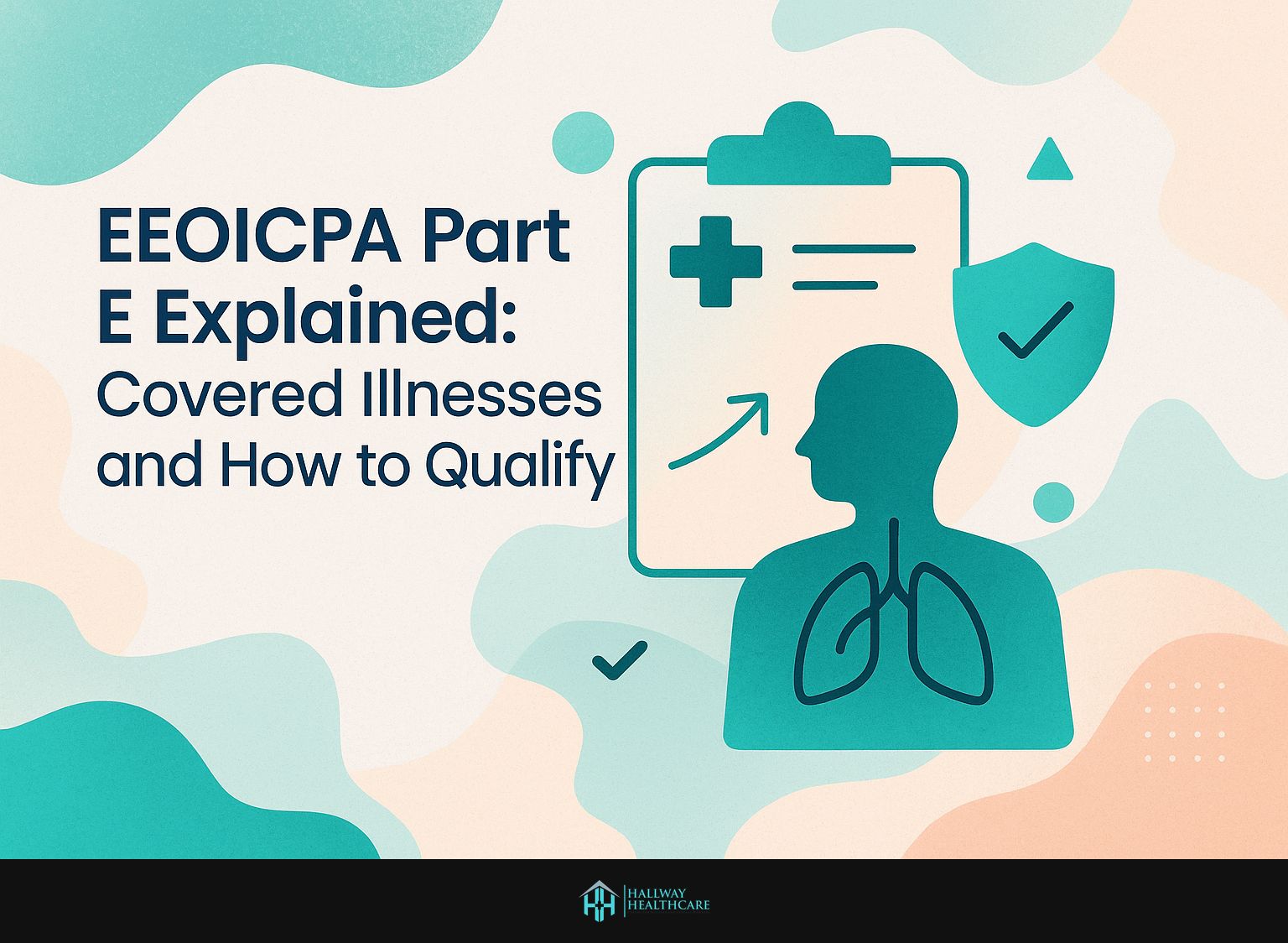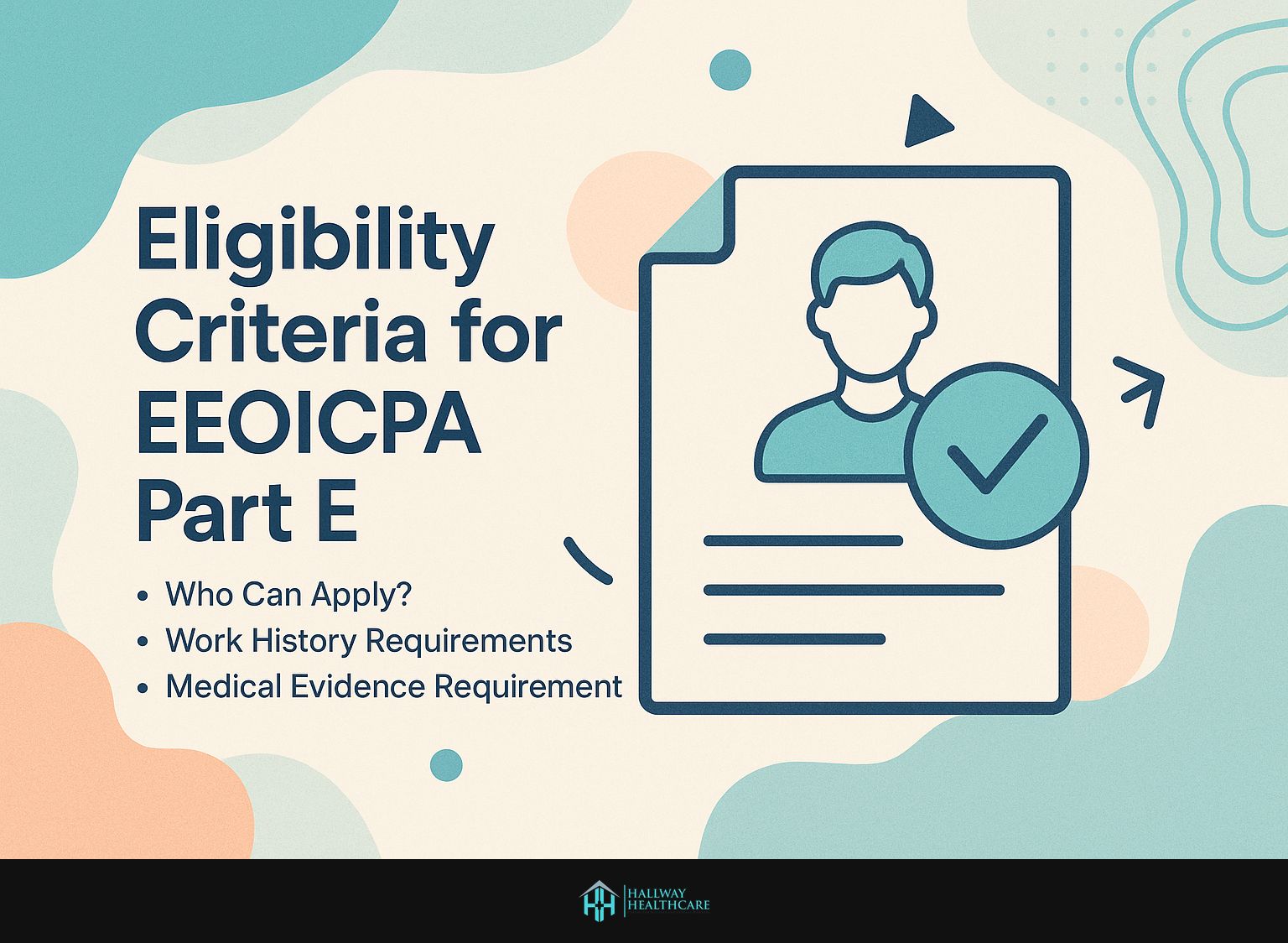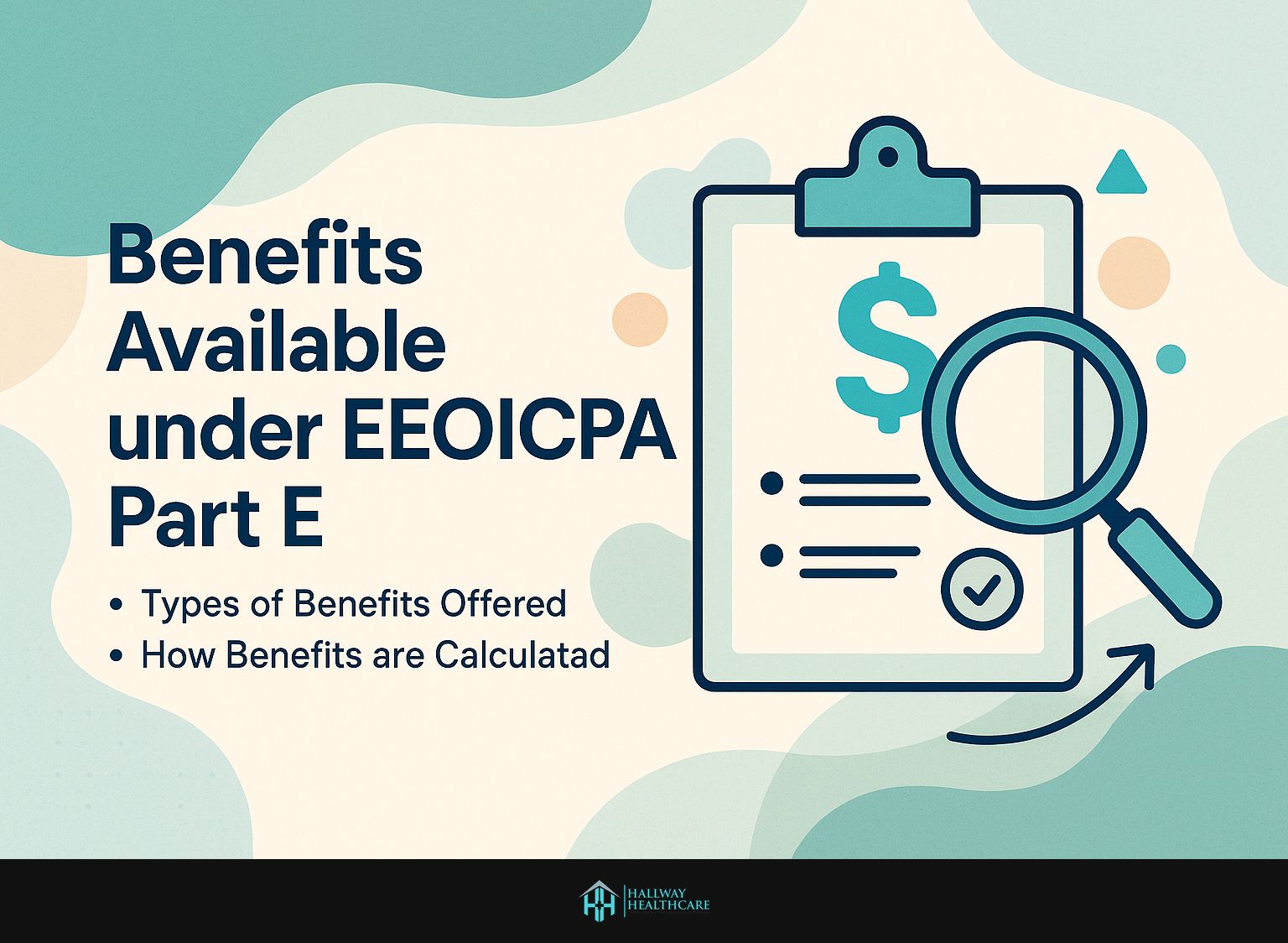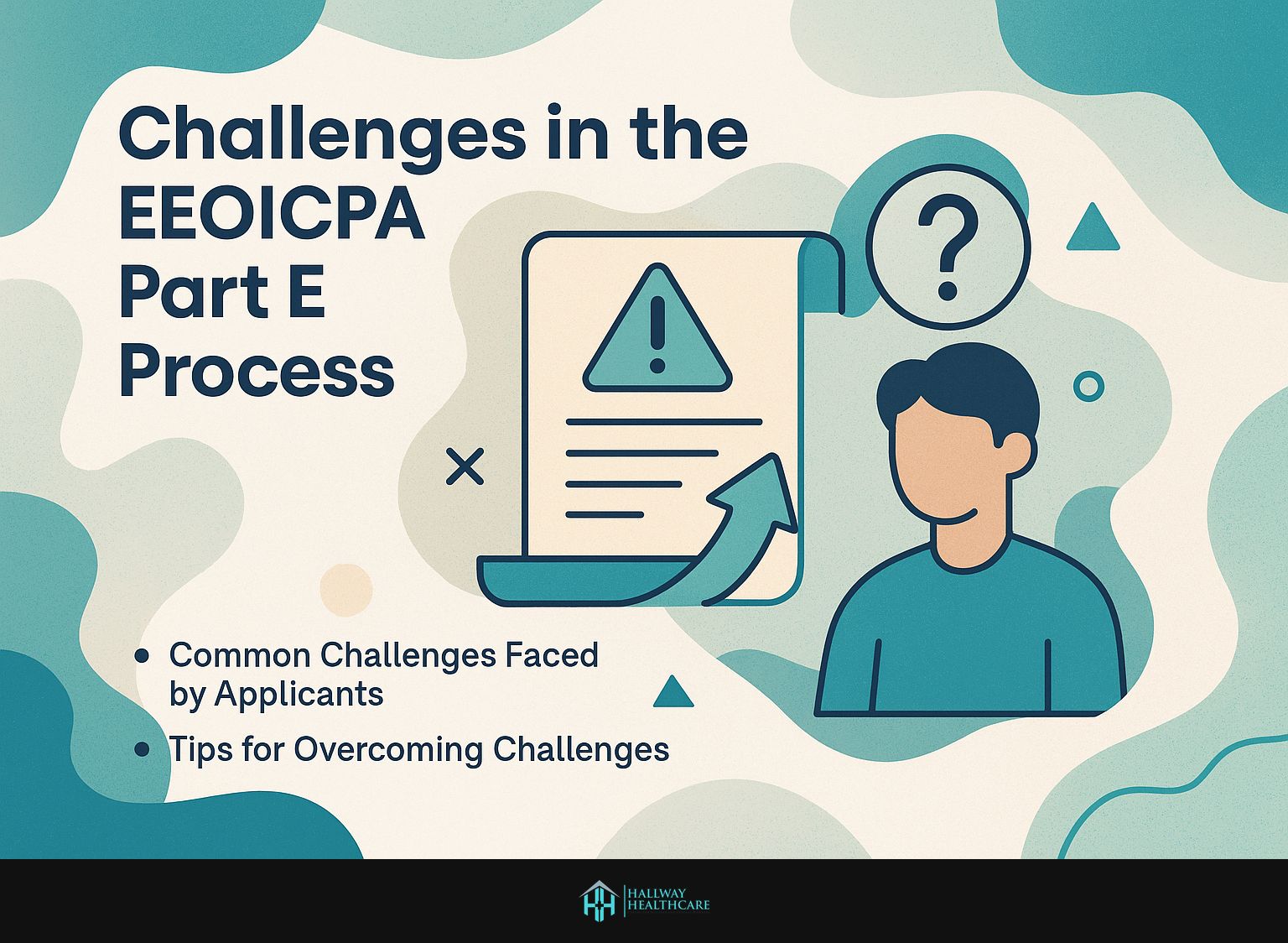
Introduction to EEOICPA Part E
Navigating the Energy Employees Occupational Illness Compensation Program Act (EEOICPA) can be challenging. This article explains EEOICPA Part E, including covered illnesses and qualification criteria. Understanding these aspects is crucial for energy employees seeking compensation for occupational illnesses, ensuring they receive the support they deserve, including medical monitoring and an impairment rating.
Key Takeaways:
- EEOICPA Part E provides compensation for covered illnesses to qualifying individuals who have been exposed to toxic substances in their work.
- Covered illnesses include various types of cancer, respiratory diseases, chronic lung disease, and other health conditions related to exposure to toxic substances.
- To qualify, applicants must have relevant work history and provide necessary medical evidence, and can seek assistance from government resources and advocacy groups during the application process, including the National Institute for Occupational Safety & Health.
Overview of EEOICPA
Established in 2000, the EEOICPA provides compensation to federal employees and contractors who suffer from occupational illnesses. It primarily addresses uranium miners and workers exposed to hazardous substances.
The program’s objectives include ensuring that affected individuals receive the necessary medical benefits and financial compensation for conditions linked to their employment. For instance, uranium miners may be eligible for compensation of up to $150,000, while individuals adversely affected by toxic chemicals can access medical benefits and treatment coverage for specific illnesses.
By addressing these critical issues, the EEOICPA plays a vital role in safeguarding the health and well-being of energy workers, supported by the Department of Health and Human Services.
Purpose of Part E
Part E provides compensation benefits to workers exposed to radiation and toxic substances in authorized facilities. It includes those recognized by the Special Exposure Cohort.
This program offers essential financial support for medical treatments related to chronic diseases, including various forms of cancer and respiratory illnesses. Eligible workers may receive compensation for treatment costs associated with conditions such as asbestosis and silicosis, which are directly linked to workplace hazards.
The application process requires the submission of medical documentation and proof of employment in the affected facilities. Survivor benefits are available, ensuring families of deceased workers don’t face financial hardship.
These measures not only address the health needs of individuals but also contribute to the promotion of safer working conditions to prevent future exposure, as guided by the Advisory Board.
Covered Illnesses Under EEOICPA Part E
EEOICPA Part E encompasses various illnesses, ensuring that eligible workers are compensated for conditions associated with toxic exposure in their work environments, including beryllium sensitivity.

Definition of Covered Illnesses
EEOICPA Part E covers illnesses related to toxic substance or radiation exposure during employment. This includes chronic beryllium disease and other chronic diseases.
Examples of such illnesses include chronic lung diseases, such as asbestosis or silicosis, as well as beryllium sensitivity, which may lead to more severe pulmonary complications.
To be eligible for coverage, these conditions must be diagnosed by a qualified physician and directly linked to exposure during employment.
The claims process requires medical records and employment history. Evidence of exposure must also be submitted, supported by the facility database.
Thorough documentation is essential. It establishes a clear connection between illnesses and toxic exposure, speeding up the claim approval process.
Categories of Covered Illnesses
Covered illnesses fall into three groups: cancer types, chronic diseases, and specific conditions from toxic exposure.
- Covered cancer types: Cancer types, such as lung cancer and kidney cancer, are often the predominant concerns, particularly for individuals who have been exposed to harmful substances.
- Chronic diseases: Chronic diseases, including chronic silicosis and Chronic Obstructive Pulmonary Disease (COPD), result from prolonged exposure and can significantly impair lung function.
- Specific conditions: Specific conditions: Other illnesses, like beryllium disease, arise from toxic exposures.
Healthcare professionals must understand these classifications. They help in diagnosing and treating patients effectively.
Specific Illnesses Included
EEOICPA Part E includes specific illnesses. These are chronic beryllium disease, lung cancer, leukemia, and kidney cancer, all linked to workplace exposure.
These conditions result from exposure to hazardous materials in the energy sector. Exposure levels are often assessed through radiation dose evaluations.
For example, chronic beryllium disease occurs as a result of inhaling beryllium dust, potentially leading to lung inflammation and respiratory failure.
Additionally, lung cancer is frequently observed among individuals exposed to radon and asbestos, while leukemia may develop from chemical exposures, such as benzene, and other toxic substances.
Statistical data shows energy workers have a much higher risk. Lung cancer rates in this group are about 50% higher than in the general population, highlighting the critical need for robust workplace safety measures and comprehensive federal compensation programs.
Documentation Requirements for Illnesses
To qualify for EEOICPA Part E benefits, applicants must submit thorough documentation. This includes medical records detailing diagnoses and treatment related to toxic exposure. This documentation should encompass detailed medical records that outline the diagnosis and treatment of conditions associated with toxic exposure, as well as exposure records that specify the chemicals involved and the corresponding timeframes.
Diagnostic reports, like lung biopsy results, must also be included.
Applicants must complete specific forms, including the EE-1 form for initial claims, along with relevant supplemental documentation. Assembling this information may be time-consuming; therefore, it is advisable to begin the process as early as possible to prevent delays in the processing of your claim.
Eligibility Criteria for EEOICPA Part E
Eligibility for EEOICPA Part E is based on specific criteria. Applicants must meet these to qualify for compensation related to occupational illnesses.

Who Can Apply?
Eligible applicants include former employees of the Department of Energy and its contractors, as well as survivors of qualified deceased workers. This eligibility applies to a diverse range of worker categories, including full-time employees, part-time staff, and subcontractor personnel who have completed a minimum of 12 months of service.
Survivors include spouses, children, or dependent parents of workers who died from employment-related conditions, and they may receive survivor benefits.
It is important to note that certain limitations apply. For example, individuals in temporary positions or those with less than one year of service may not qualify.
Therefore, it is essential to review specific job descriptions and the duration of employment to accurately assess EEOICPA eligibility.
Work History Requirements
Applicants must provide verifiable evidence of their work history. This history must be from an authorized facility to qualify for EEOICPA Part E benefits. To fulfill this requirement, candidates are advised to maintain comprehensive records of their employment, which should include tax documents, pay stubs, and W-2 forms that cover a minimum of 24 months of work at a facility engaged in handling radioactive materials or producing nuclear weapons.
Acceptable employment includes positions at government-owned plants, contractors, or mining operations. The documentation must clearly indicate periods of employment and specific job responsibilities to establish eligibility.
By maintaining organized records, candidates can streamline the claims process and increase their chances of securing benefits.
Medical Evidence Requirements
Medical evidence requirements need clear documentation. This documentation must support the diagnosis of a covered illness linked to occupational exposure.
Essential documents include diagnosis reports, treatment records, and letters from healthcare providers. These reports must clearly articulate the illness and include specific details pertaining to exposure, ideally with dates and circumstances that are directly related to the workplace.
For example, in the case of a respiratory illness, it is important to include evidence such as:
- Chest X-rays
- Pulmonary function tests
- Assessments of the work environment
Clear documentation boosts the credibility of a claim. Ensure all records are dated and signed by licensed professionals.
Application Process for EEOICPA Part E
Navigating the application process for EEOICPA Part E can be complex. It requires careful attention to detail and following established procedures, especially for Energy Employees with Occupational Illness.
Step-by-Step Guide to Application
To successfully submit your EEOICPA Part E application, please follow this step-by-step guide:
- Confirm your eligibility,
- Gather the necessary documents,
- Complete the application form, and
- Submit it to the Department of Labor.
To confirm eligibility, check if you worked in a covered employment sector like uranium mining or Department of Energy (DOE) facilities. Ensure you meet the criteria for the Special Exposure Cohort.
Next, collect the required documents, which should include proof of employment, medical records, and any relevant awards, ensuring to include worker records.
Utilize the Department of Labor’s official website to access the application form, ensuring that you fill out each section comprehensively and consult with the Department of Health and Human Services if needed. It is vital to double-check for accuracy before printing and signing your application. The completed application should then be submitted via mail to the address designated for your state.
It is advisable to aim for the completion of each step within a week to facilitate a smooth application process.
Common Application Mistakes
Applicants often encounter common errors that can delay or jeopardize their claims under EEOICPA Part E, such as submitting incomplete documentation and using incorrect forms related to worker exposure. Plus issues related to incomplete documentation, applicants frequently overlook critical deadlines and fail to provide necessary supporting evidence.
For instance, missing the 30-day submission window can result in automatic denials of claims.
It is essential to use a comprehensive checklist when preparing a claim. This ensures all required forms are included and properly signed. A misunderstanding of eligibility criteria, such as those involving the Radiation Exposure Compensation Act, can lead applicants to submit incorrect forms, ultimately resulting in wasted time.
To mitigate these pitfalls, it may be beneficial to consult a specialist or use resources like the EEOICPA Resource Center to address all aspects of Chronic Obstructive Pulmonary Disease or lung issues. Regularly reviewing submitted applications can aid in identifying trends in common errors and improving the overall quality of future submissions.
Benefits Available under EEOICPA Part E
EEOICPA Part E offers benefits to help energy employees and their families affected by occupational illnesses.

Types of Benefits Available
EEOICPA Part E offers three main benefits: medical benefits, wage loss compensation, and survivor benefits.
Medical benefits cover necessary treatments for exposures at designated facilities. This includes services like chemotherapy and routine medical consultations, all at no cost.
Wage loss compensation helps those whose earnings dropped due to work-related illnesses. Applicants are required to submit financial documentation to evaluate their eligibility.
Survivors of deceased workers can claim benefits that provide essential financial support for their families. Submit claims on time. For detailed application processes and eligibility criteria, consult the official website.
How Benefits are Calculated
Benefits depend on factors like illness severity, wage loss, Probability of Causation, and medical expenses.
Start by gathering medical documentation that verifies your diagnosis and treatment history. Consulting a lung specialist can also help.
Next, calculate your lost wages based on previous earnings and the duration of your illness. For instance, if your annual salary was $50,000 and you were unable to work for a period of two years, this would amount to a total of $100,000 in lost wages.
Keep detailed records of medical bills and expenses. These costs may be reimbursed. By compiling this information, you will be able to present a well-supported case for your benefit claim.
Challenges in the EEOICPA Part E Application Process
Navigating EEOICPA Part E presents challenges that applicants must recognize to improve their chances of compensation.

Common Challenges Faced by Applicants
Common challenges include misunderstandings about eligibility, incomplete documentation, and claim processing delays.
A significant issue is the misunderstanding of eligibility criteria, which can result in wasted time and effort on claims that are ultimately denied. For example, applicants may miss specific income limits needed for qualification.
Additionally, incomplete documentation often leads to processing delays; for example, the absence of essential medical records can prolong the timeline by several weeks. Applicants frequently face extended processing times due to a backlog in claims, especially those needing dose reconstruction information.
Thus, gaining an understanding of these challenges can enable individuals to prepare more effectively and enhance their prospects for a successful outcome.
Tips for Overcoming Challenges
To tackle challenges in the EEOICPA Part E application, use effective strategies like thorough documentation and professional guidance.
Start by gathering all relevant medical records, work histories, and correspondence with the Department of Energy. Utilizing digital tools, like Google Drive, can facilitate the organization and sharing of documents with your support team.
Additionally, consulting advocacy groups like the Energy Employees Occupational Illness Compensation Program Act Resource Center can offer expert advice tailored to your specific circumstances.
Create a timeline for your application to track progress and deadlines. This helps ensure no critical steps are missed.
Valuable Resources
Many resources are available to help EEOICPA Part E applicants navigate the compensation process.

Government Resources
Government resources, including the Department of Labor website, offer crucial information and support for EEOICPA Part E applicants.
The Department of Labor encourages applicants to visit the Energy Employees Occupational Illness Compensation Program website. It offers step-by-step guides for filing claims.
The National Institute for Occupational Safety and Health (NIOSH) is another important resource. Users can access dose reconstruction information to establish exposures.
For direct assistance with claim status or applications, contact the EEOICPA helpline at 1-866-888-3322. You can also reach out to the Department of Justice for support.
Support from Advocacy Groups
Advocacy groups offer vital support to EEOICPA Part E applicants. They help navigate the complexities of the compensation system.
Organizations like the Energy Employees Occupational Illness Compensation Program (EEOICPA) Support Center provide free consultations. They help applicants collect necessary documentation.
The National Association of Chemical Disasters and Nuclear Workers (NACDNW) helps individuals understand eligibility criteria. This includes workplace exposure and cancer diagnosis, and they connect applicants with legal resources for claims.
Connecting with these organizations can simplify the application process. They provide professional support at every step, increasing the chances of receiving compensation.
 Skip to content
Skip to content
